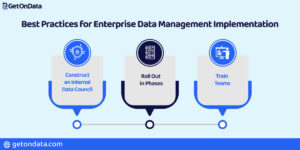Business leaders today are confronted with data from all directions. Sales, marketing, operations, and customer service all create great quantities of information. But without a recognized process to handle it, decisions may be sluggish or incorrect. If your business experiences issues such as bad reports, orphaned systems, or disorganized customer files, it’s time to think about enterprise data services and create a solid framework around your data.
This guide explains what Enterprise Data Management (EDM) means, why it’s more important than ever, and how leaders can drive successful change using data. You’ll learn how to choose the right enterprise data solutions, connect them to your business goals, and use the best tools for enterprise data management to stay competitive.
Enterprise Data Management is the activity of gathering, organizing, safeguarding, and holding data throughout the whole company. It guarantees that the appropriate individuals may access secure, consistent, and clean data when they need it. Rather than coping with a multitude of spreadsheets or dysfunctional systems, EDM provides all teams with one, reliable source of information.
With the use of reliable enterprise data services, businesses are able to collaborate more effectively, prevent duplicate records, and obtain a holistic view of their operations. EDM enables solid reports, dependable forecasts, and improved business plans.
Companies with no firm enterprise data platform in today’s digital era tend to suffer. Their information is locked away in isolated systems that do not integrate. This leads to confusion, latency, and opportunity losses.
With a modern enterprise data platform, your data is connected and accessible to finance, marketing, sales, or customer service. These integrated systems and robust enterprise data analytics platforms enable teams to monitor trends, analyze performance, and discover new paths for growth. In today’s economy, trustworthy data is no longer a choice. It’s the foundation for every informed decision.
This guide is designed for business and tech leaders alike. CIOs and CTOs are looking to refresh antiquated systems. Chief Data Officers are constructing clear frameworks. Business executives also aim to make better, fact-based judgments. They can all benefit from robust enterprise data solutions.
Regardless of whether your role is strategic or technical, knowing EDM can enable you to make quicker decisions, lead more successfully, and connect business objectives with real-time data insights.
What is Enterprise Data Management and Why Should Executives Care?
1.Strategic definition and business value
A major area of concentration for the company, enterprise data management is more than just a technical function. It has a crucial function in assisting businesses to operate efficiently and make intelligent decisions. At a strategic level, EDM supports better decision-making by giving leaders access to clean, trusted data. Reports are faster and more accurate. Teams don’t waste time fixing mistakes or tracking down missing numbers.
A good enterprise data management strategy provides executives with a transparent understanding of the company’s performance. They can leverage this information to create budgets, improve customer satisfaction, and assess outcomes. Thus, accurate data translates to better decisions and less guessing. This is why savvy companies consider EDM a crucial part of their growth and success.
2.The difference between tactical vs. enterprise-level data handling
Tactical data solutions, such as spreadsheets or stand-alone dashboards, are useful for small or one-off tasks. Quick fixes or ad-hoc reports work well with them. However, as your business evolves, these tools cannot keep pace. They cause silos, mistakes, and delays.
That’s where enterprise data management tools can help. By gathering all of your information in one place, they assist you. They normalize formats, remove duplicate records, and secure everything department by department. Your teams no longer work in isolation, but from one reliable source of data.
Businesses are more efficient overall as a result of this transition from tactical to strategic data management. It also enables long-term growth by ensuring everyone gets to work with accurate, current information.
3.Why is data a boardroom topic in 2025?
In 2025, investors and boards of business want more than mere rudimentary reports. They need precise, accurate, and current information. They want to view transparent figures so that they can gauge how the business is faring.
Nowadays, data is not only a technical matter; it’s a boardroom issue. It impacts risk, revenue, and reputation. Inaccurate or incomplete data can lead to poor decisions, unachieved goals, or even legal problems.
That’s the reason it’s essential to possess a robust and scalable enterprise data management platform. Businesses risk falling behind their rivals without it. They can also be audited, fined, or experience public trust issues. Leaders need to take the initiative to drive clean, well-managed data. It’s no longer just IT’s responsibility. It begins at the top.
The Business Impact of Enterprise Data Management
1.How does it improve decision-making speed and accuracy?
When leaders make use of trustworthy enterprise data services, they avoid issues due to poor or dirty data. Bad data slows down the work and is confusing. Teams might waste hours correcting numbers or cross-checking reports.
With reliable enterprise data services, those delays go away. Teams can get accurate and up-to-date information more quickly. This empowers leaders to make better decisions more quickly. Instead of scrubbing spreadsheets or making educated guesses about what’s correct, teams can do what the data is indicating.
This results in increased assurance, decreased risk, and more intelligent decisions made by the entire organization.
2.Enhancing customer experience through data consistency
Customer information tends to be duplicated across numerous systems. One may provide sales information, another may provide support, and a third may keep an eye on marketing. This renders it difficult to glimpse the entire picture of each customer.
With a unified data approach, companies can solve this issue. They can consolidate all the information into a single, clear, complete picture. This will make it so that all the teams’ marketing, sales, and support can view the same information.
Consequently, the service becomes smoother and personalized. Customers shouldn’t have to say the same thing twice. They receive quicker responses and improved offers. This establishes trust and enhances loyalty. Trustworthy enterprise data services enable all this. They allow companies to bring data together, minimize confusion, and improve the experience of customers as well as teams.
Also read :- Data Engineering in 2025: Key Trends Shaping the Future
3.The Value of Enterprise Data Services
The strength of enterprise big data management platforms comes to light when firms are handling enormous and sophisticated volumes of data. These consist of customer histories, web traffic, purchase behavior, and so on. Processing all this manually or with simple tools simply does not cut it anymore.
That is where enterprise big data solutions fit in. These applications are designed to handle lots of data at a fast pace. They allow companies to observe trends, analyze information instantly, and react more quickly.
With enterprise big data solutions that scale, businesses are able to identify patterns, monitor how customers behave, and even anticipate forthcoming action. It assists them in making better plans, smarter choices, and staying competitive.
4.Real-world ROI examples across industries
One global retailer had a massive issue with duplicate product listings. A lot of their products were listed multiple times under varying codes or names. This made both staff and customers confused. They decided to handle it with enterprise master data management tools. These tools assisted them in streamlining their product catalog and eliminating duplicates. Through this, they reduced duplicate SKUs by 40% and experienced a definite sales increase.
In one instance, a transportation company was having issues with late or inaccurate deliveries. They wished to optimize the way they tracked routes and driver performance. Thus, with enterprise data analytics solutions, they could track deliveries in real-time. This enabled them to make more intelligent route choices and fewer errors. Their delivery accuracy increased by 25%.
These practical illustrations demonstrate that enterprise data management, or EDM, is more than simply a theory. When implemented correctly, it delivers actual business value and solid returns.
Enterprise Data Management Strategy: What Leaders Must Prioritize
1.Aligning EDM with business goals
Your enterprise data management strategy should always start with your business objectives. Consider this: What aspects do you wish to improve? Is it quicker reporting, more valuable customer insights, or better compliance with laws and regulations?
Begin by creating a list of your most urgent business needs. Next, examine how your information can be used to solve those issues. This helps you focus on what matters the most.
Once your needs are defined, select enterprise data solutions that align with them. The correct tools should assist you in your particular business goals, not simply handle data, but also aid you in leveraging it more effectively. In this way, your data strategy remains valuable and targeted as your organization expands.
2.Balancing agility, scalability, and governance
A good Enterprise Data Management (EDM) must be more than simply putting data in its place. To encourage creativity and generate fresh concepts, it must be sufficiently strong. Yet it must, at the same time, still safeguard data and play by the rules.
This is a fine balancing act. You need teams to go fast, but you also need to have some control over data privacy and quality. That’s why it’s intelligent to invest in enterprise data management software that can scale with your company. The most effective software allows you to expand without compromising precision or sacrificing security protocol. With proper implementation, you can remain responsive and secure simultaneously.
3.Building data ownership and accountability across departments
Having defined roles for data ownership is a key element of any enterprise data management strategy. Once individuals know their role, they take ownership and watch it more closely for accuracy.
This establishes accountability within departments. It prevents mix-ups or errors from occurring when data updates or requires changes.
With the aid of proper training and good governance rules, teams are able to handle their data better. Having good enterprise data management tools also makes the task easier. By using these tools, teams can make sure they follow best practices and minimize the chance of mistakes. The quality of your data improves across the company when you collaborate.
Key Benefits of Enterprise Data Management for C-Level Executives
For company executives, a well-thought-out enterprise data management strategy offers many benefits. When trusted and well-managed data exists, it becomes an influential asset companywide.
Here’s how a solid EDM strategy benefits:
1.Smarter, faster digital transformation: Clean, trustworthy data fuels AI applications, automation, and sophisticated analytics. Thus, this makes your technology smarter and more productive.
2.Easier compliance and reduced legal risk: With well-defined rules and governed data, businesses have an easier time complying with laws and industry regulations. Thus, it reduces the chances of getting fined or having data leaks.
3.Improved operational performance: Clean and integrated data means fewer mistakes, less redundant work, and quicker workflows. Therefore, teams dedicate less time to fixing mistakes and more time to completing the tasks.
4.Improved investor confidence: Transparent, reliable reports from reputable information sources indicate that your company is sound and efficiently managed. Executives can speak from facts, not assumptions.
A good enterprise data management approach assists leadership in making decisions quickly, lowers risks, and establishes a company culture that values data. It’s not about the systems, it’s about making the whole business stronger and more efficient.
Critical Components of a Strong Enterprise Data Management Framework
A reliable architecture for enterprise data management includes:
1.Master Data Management (MDM): Employ enterprise master data management software to maintain consistency in the main records such as customers, products, and suppliers.
2.Data Quality Management: Ensure your data is up-to-date and correct using native validation, deduplication, and cleansing mechanisms.
3.Metadata Management: Thus, specify where the data comes from, how it’s meant to be used, and who owns it.
4.Governance and Security at Scale: Thus, protect your data with access controls, encryption, and audit logs.
All these are fundamentals of any serious enterprise data solutions implementation.
Top Enterprise Data Management Platforms for Large Organizations
Any organization’s selection of the appropriate enterprise data management tool is a critical one. Your chosen tool will influence the extent to which your data is well organized, shared, and secured. It also determines how easily your teams can interact with and utilize that data.
Leaders need to consider leading platforms such as Informatica, SAP, Talend, Collibra, Snowflake, and IBM InfoSphere. They are commonly utilized for a reason, but each has different characteristics. Some are suitable for big companies. Others are more adaptable or affordable. Setup time, costs, and technical support also differ.
Always check that your tools work smoothly. Especially tools like CRM, ERP, or cloud setup. It must be able to assist your company as it scales and ensure you are compliant with data privacy regulations.
Some offer several features in one. For instance, they might provide enterprise data analytics platform functionality, as well as master data management (MDM) and data governance capabilities. Having all these features in one package might save time and lower the requirement for additional software.
In brief, the ideal enterprise data management solution is the one that meets your needs today and accommodates future expansion. Make a good choice, and your data will be one of the strongest assets of your business.
Best Practices for Enterprise Data Management Implementation
For successful EDM implementation:
1.Construct an Internal Data Council: Unite IT, business units, and compliance teams to assist in making decisions.
2.Roll Out in Phases: Pilot small, perhaps one business area or one domain of data, and then scale. Speed wins deliver momentum.
3.Train Teams: Get employees to use new tools and adhere to governance rules. One can only win when it’s a collective effort.
Also read :- Top 7 Data Visualization Tools Every C-Level Executive Should Consider
Common Enterprise Data Management Challenges and How Leaders Can Solve Them
Many companies continue to operate on obsolete, legacy systems. Typically, these systems do not work together. A department will be using software different from another department. This produces data silos, frustration, and timelines.
To remedy this, businesses must invest in integration. Current enterprise data services assist in connecting these systems and consolidating all the data into one location. It is simpler to manage, access, and trust the information.
When funds are limited, getting approval for such an update can be difficult. To secure backing, demonstrate how your enterprise data management strategy is directly connected to business outcomes such as quicker reporting, reduced errors, or improved customer service.
Another difficulty is getting the appropriate balance between freedom and oversight. It’s fine to allow departments to control their data. But you still require central guidelines and standards to ensure everything remains consistent and safe. That’s where governance comes in.
And never forget this: if your raw data is bad, your conclusions will be incorrect. How sophisticated your tools are doesn’t matter. Thus, garbage in, garbage out. The secret to effective enterprise data analysis is clean data. Lacking it, your choices might rely on errors you fail to detect.
Future Trends in Enterprise Data Management: Decision Makers Should Prepare For
Today’s world of data is in constant flux. The real-time data fabric is one of the biggest trends. This technology enables companies to access data instantly, no matter where it is stored. Teams can draw from various systems instantly. This implies quicker decisions and faster responses to business shifts.
Another large change is the employment of AI. Artificial intelligence is now assisting businesses in managing data. It can detect issues, correct mistakes, and apply rules on its own. AI also reduces manual labor and improves data quality. This simplifies data governance and makes it more consistent.
People are also seeing more companies move to cloud-based systems. Enterprise data management platforms are now built in the cloud. So are enterprise big data management platforms. These modern tools are faster, more scalable, and easier to update. They also give businesses more flexibility to grow and adapt over time.
These trends show one clear message: the future of data is real-time, smart, and cloud-native. Early use of these tools will give businesses a major advantage.
Ready to Take Control of Your Enterprise Data?
Using strong enterprise data services and building a clear enterprise data management strategy can set your business up for long-term success. It’s not only about handling data; it’s about leveraging it to expand, enhance, and contend.
Appropriate enterprise data management tools are essential for achieving better results. You also need to assign ownership. Make sure every team knows who is responsible for the data they use. This preserves the reliability of your data and fosters responsibility.
Change doesn’t happen overnight. Break your plan into small, clear steps. Focus on quick wins first, then scale up over time. This makes it easier for teams to adapt and stay on track.
Begin with the result you want. Do you need faster decision-making? Start there and pick the tools and strategy that support that goal.
Today, enterprise data management is not optional. It’s a must. Tools like enterprise data analytics solutions and enterprise master data management tools help leaders work with confidence. They reduce risks, make data more reliable, and help you find real business value.
If you’re ready to take control of your data and get expert help, get in touch with professionals for solutions built to support your business goals.




